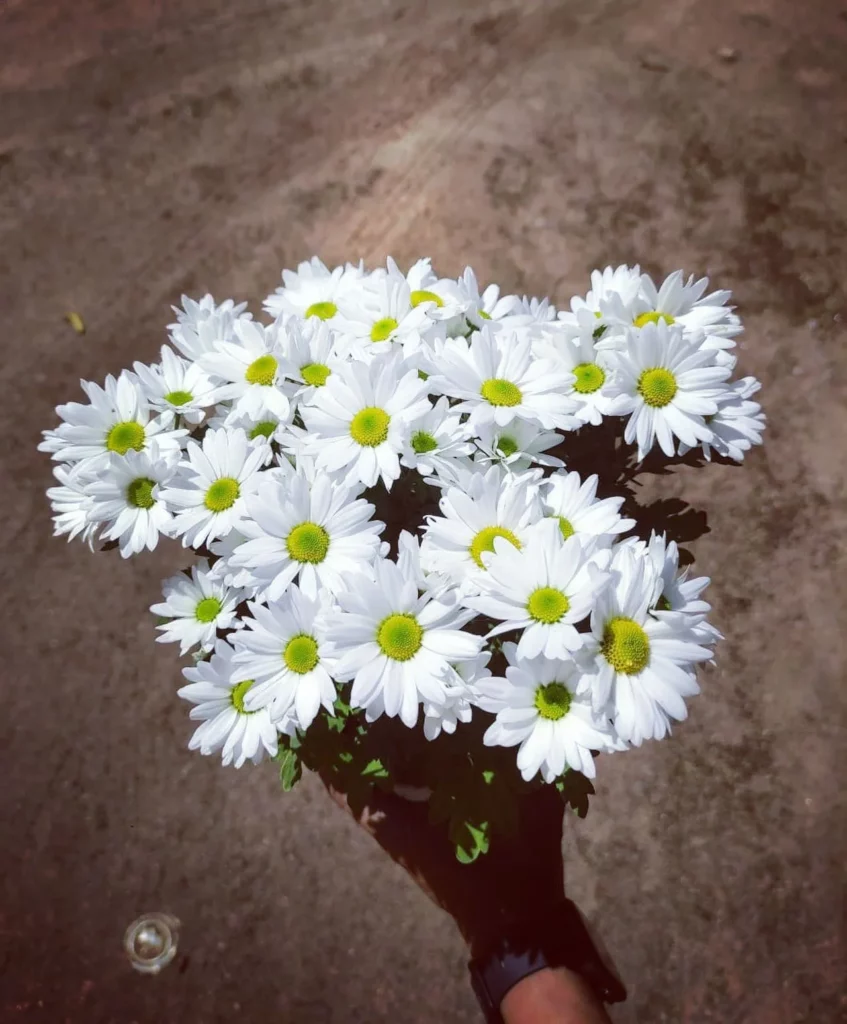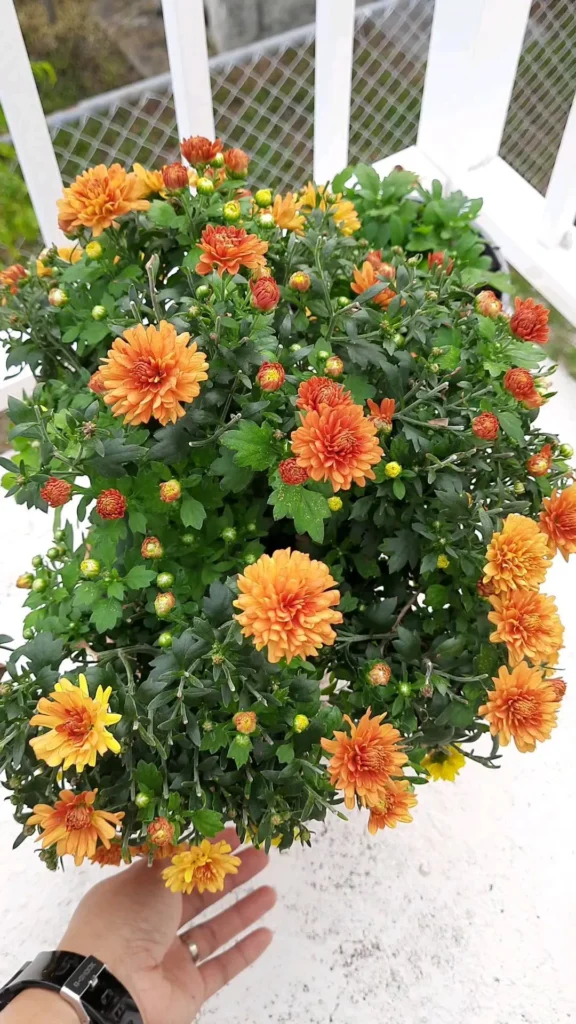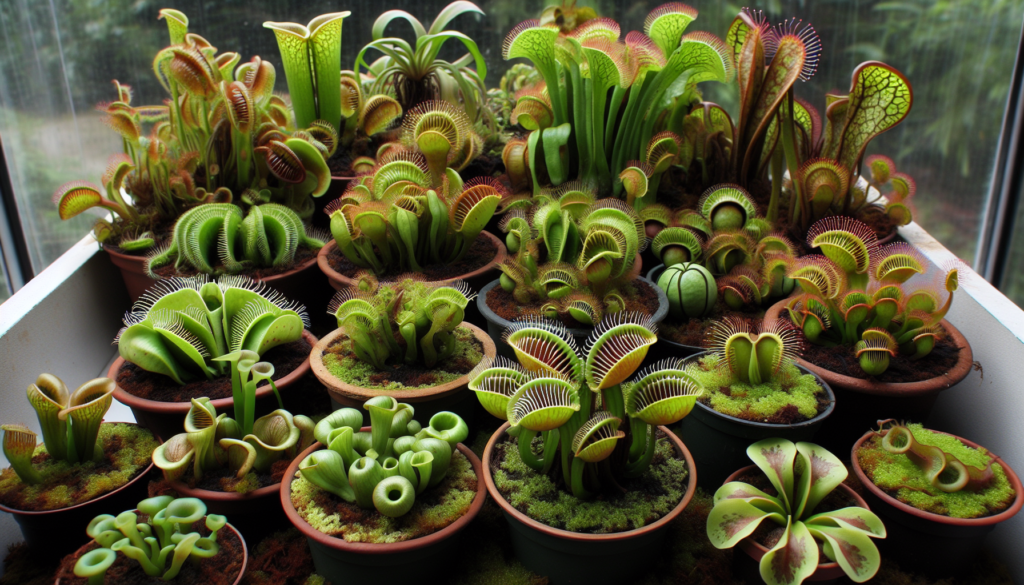Chrysanthemums, also known as mums, are herbaceous perennial plants that add a burst of color to gardens and floral arrangements. With a mature height of 2-3 feet, these blooms belong to the Asteraceae family and are native to Asia and Europe.
Chrysanthemum Appearance
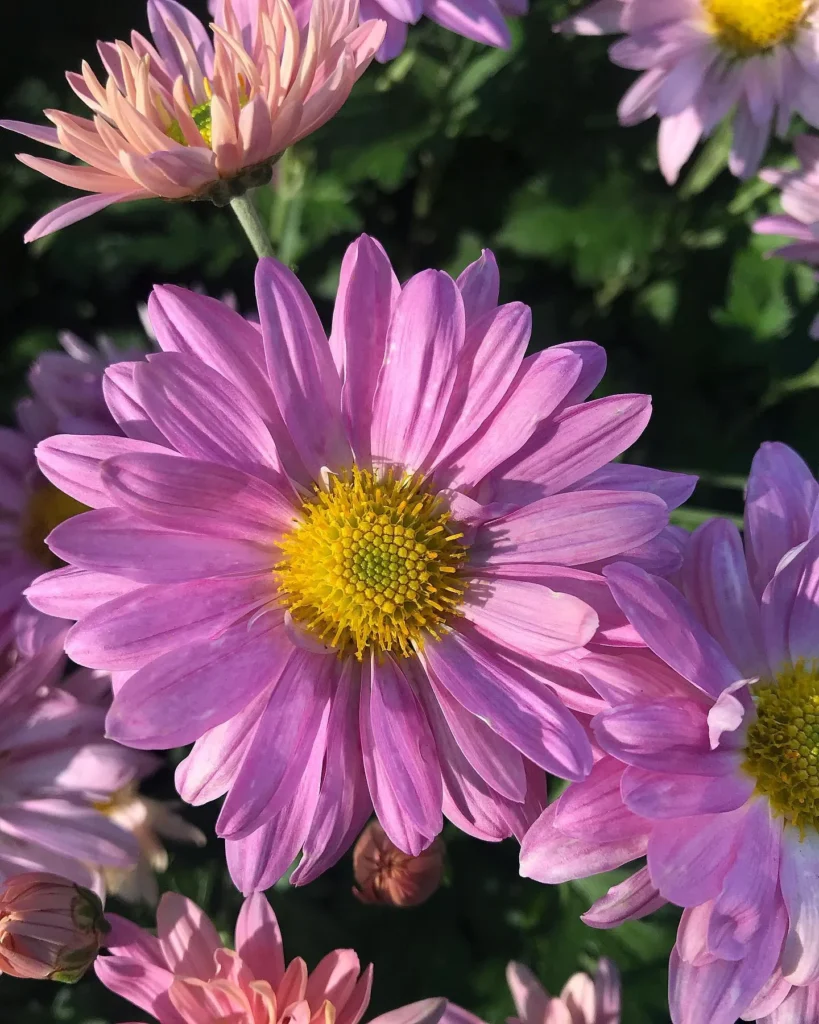
Chrysanthemums come in a stunning array of colors, including white, yellow, orange, red, pink, and purple. Their vibrant hues make them a popular choice for fall displays. In addition to their dazzling colors, chrysanthemums also come in various petal shapes, from single, daisy-like blooms to pompoms and button-like arrangements.
The variety of chrysanthemum colors and petal shapes make these flowers incredibly versatile. Whether you’re aiming for a classic, elegant look or a vibrant and bold display, there is a chrysanthemum variety to meet your preferences.
These prolific bloomers grace gardens during the summer and fall seasons, offering a delightful burst of color while many other plants start to fade. Their long-lasting flowers and sturdy stems make them excellent cut flowers as well, perfect for creating eye-catching floral arrangements for any occasion.
In the next section, we will dive into the specific light requirements that chrysanthemums need to thrive and produce their stunning blooms.
Chrysanthemum Light Requirements
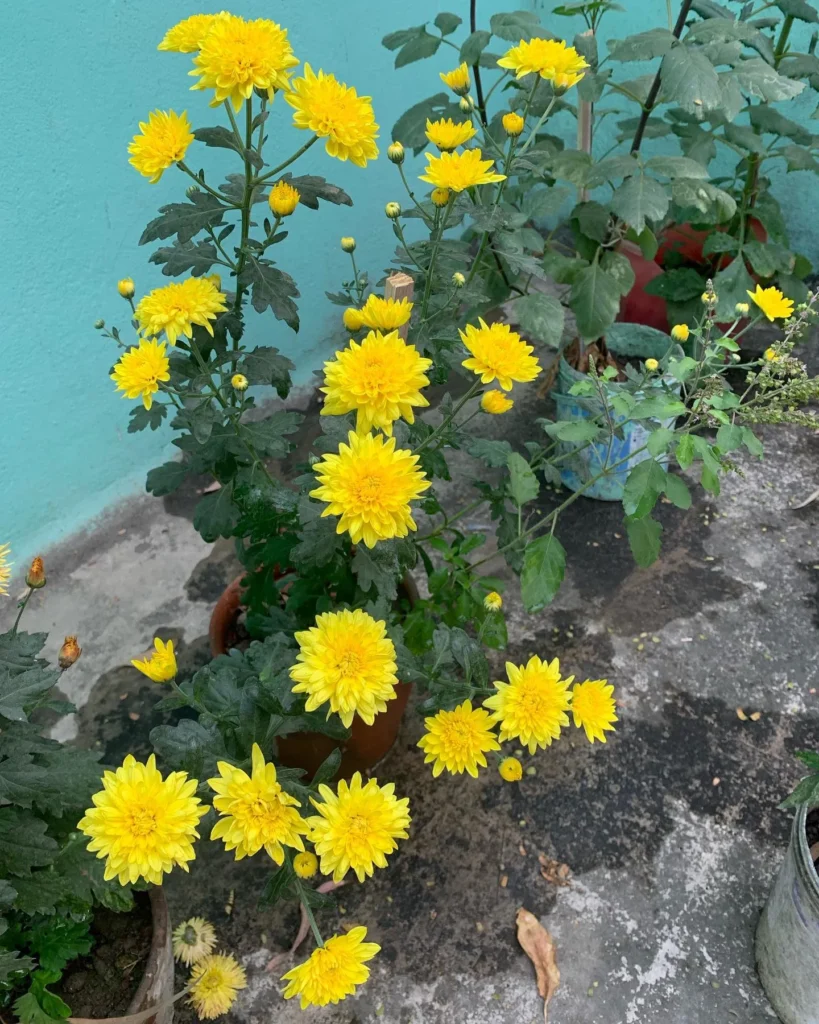
Chrysanthemums, also known as mums, are vibrant and stunning flowers that require specific light conditions to thrive. Understanding the light requirements of chrysanthemums is crucial for ensuring their healthy growth and abundant blooms.
Chrysanthemums thrive in full sun conditions, making it essential to provide them with at least six hours of direct sunlight each day. This exposure to sunlight is vital for their photosynthesis process and overall development. When exposed to adequate sunlight, chrysanthemums produce the fullest plants and most beautiful blooms.
While chrysanthemums can tolerate some partial shade, they truly flourish in full sun. By placing them in an area that receives ample sunlight, you can promote their healthy growth and encourage more abundant flower production.
To provide sufficient sunlight for your chrysanthemums, choose a location in your garden that offers unobstructed access to the sun for most of the day. Avoid areas that are heavily shaded or receive only dappled sunlight, as this may hinder their growth and affect their ability to produce vibrant blooms.
Chrysanthemum Watering
Proper watering is essential for the health and vitality of your chrysanthemums. These lovely flowers prefer evenly moist soil, so it’s important to pay attention to their water requirements.
Chrysanthemums should be watered when the top 1 inch of soil feels dry to the touch. This ensures that the plants have enough moisture for optimal growth without becoming waterlogged.
When watering your chrysanthemums, it’s important to focus on the soil level and avoid watering the blooms directly. Watering the blooms can lead to diseases, so it’s best to direct the water towards the soil instead.
Remember to water the chrysanthemum plants until the soil is moist, but be careful not to overwater and make the soil soggy. Overwatering can lead to root rot and damage the plant’s overall health.
If you are growing chrysanthemums in pots, it’s important to water the surface of the soil until moisture begins to drain from the bottom of the pot. This ensures that the roots receive enough water and excess moisture can escape.
- Water chrysanthemums when the top 1 inch of soil feels dry.
- Avoid watering the blooms directly to prevent diseases.
- Maintain moist but not soggy soil to prevent root rot.
- For potted chrysanthemums, water until moisture drains from the bottom of the pot.
Chrysanthemum Fertilizing
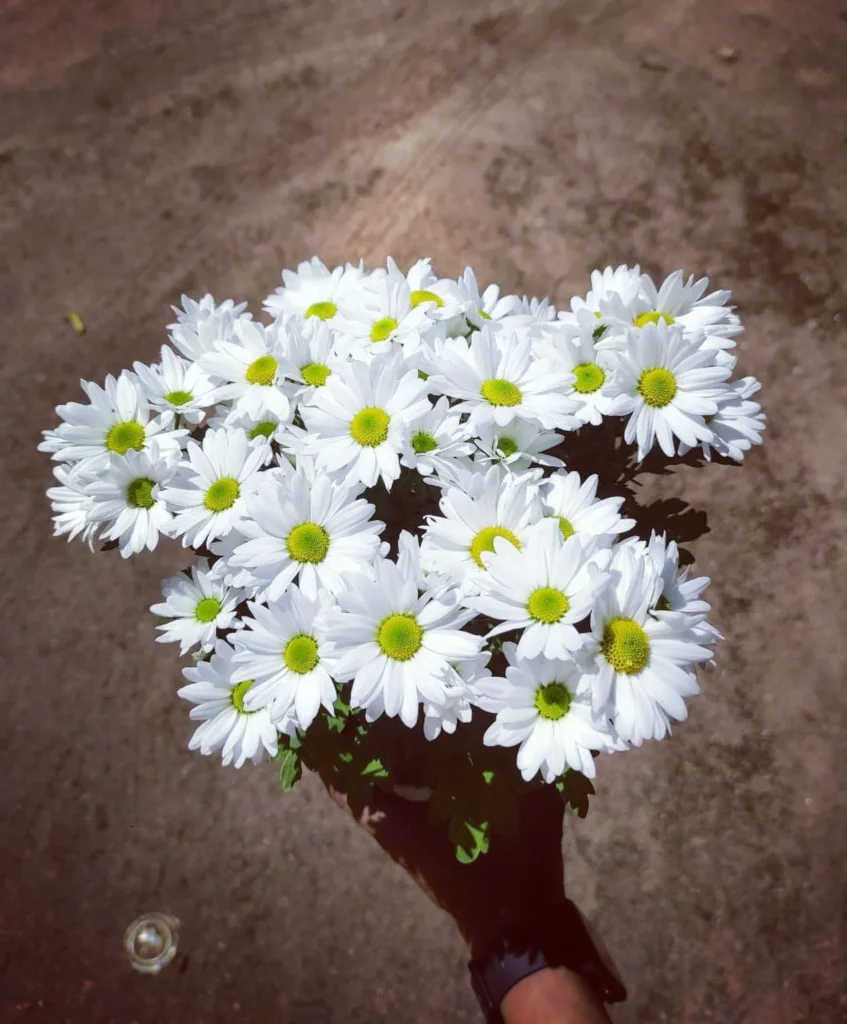
Proper fertilizing is crucial for the healthy growth and abundant blooms of chrysanthemums. These vibrant flowers benefit from regular fertilization, especially during their vegetative phase.
When planting and during the vegetative growth period, it is recommended to use a 20-10-20 fertilizer, which contains essential nutrients to support their development. This balanced formulation ensures that chrysanthemums receive the right blend of nutrients for optimal growth.
Once the chrysanthemums are established, you can switch to a 5-10-5 liquid fertilizer. This type of fertilizer provides the necessary nutrients in a readily available form.
Start fertilizing your chrysanthemums after the danger of frost has passed, typically in early spring or late winter. Always refer to the product label instructions to determine the correct amount of fertilizer to use for your specific garden. Over-fertilizing can be detrimental to the plants, so it’s important to follow the recommended dosage.
However, it’s crucial to stop fertilizing established chrysanthemums after July. This helps prevent damage from potential frost and allows the plants to transition into their natural dormancy period.
Incorporating these fertilizing practices into your chrysanthemum care routine will provide the essential nutrients necessary for healthy growth and the beautiful blooms that these flowers are known for.
Chrysanthemum Potting
Repotting chrysanthemums is essential for their healthy growth and development. When it comes to chrysanthemum potting, here are a few steps to follow:
- Choose a pot that is slightly larger than the original container. This will provide enough space for the roots to spread and grow.
- Fill the bottom of the new pot with potting soil. This will ensure proper drainage and aeration for the chrysanthemum plant.
- Gently break up any tangled roots before placing the chrysanthemum plant in the new pot. Be careful not to damage the roots during this process.
- Position the chrysanthemum plant in the new pot, making sure that the soil surrounds the roots completely. Avoid burying the stem too deep.
- Water the chrysanthemum thoroughly until water drains from the bottom of the pot. This will help the plant settle into its new environment.
Chrysanthemum Propagation
Chrysanthemums can be propagated through division and cuttings, making it easy to expand your chrysanthemum collection and share them with others.
Division
Division is the simplest and quickest method of chrysanthemum propagation. If you already have established chrysanthemum plants in your garden that are at least two years old, you can divide them to create new plants.
To divide chrysanthemums, carefully untangle the roots of an existing plant and gently separate them into multiple clumps. Replant each clump at the same depth as the original plant. Ensure that each new division has its own set of roots.
This method allows you to create multiple plants from a single mature chrysanthemum, guaranteeing healthier root systems and increasing the chances of successful growth.
Cuttings
Another method of propagating chrysanthemums is through cuttings. This method involves taking a stem from a healthy chrysanthemum plant and encouraging it to grow roots.
Start by selecting a healthy stem with at least two sets of leaves. Make a clean cut just below a node (where the leaves attach to the stem) using a sterilized knife or shears.
Dip the cut end into a rooting hormone to encourage root growth, then plant it in a container filled with moist potting mix. Make sure the cutting is inserted at least an inch into the soil to provide stability.
Place the container in a warm location with bright, indirect light. Mist the cutting regularly to maintain humidity and prevent the soil from drying out. After a few weeks, the cutting should develop roots.
Once the roots have grown a few inches in length, transplant the young chrysanthemum outside into a prepared flower bed or container.
Pruning Knife for Garden
$12.99
Chrysanthemum Growth and Development
Chrysanthemums, like any other plant, require proper care and maintenance for optimal growth and development. Here are some essential tips to ensure your chrysanthemums flourish:
1. Pruning and Pinching
Pruning and pinching are crucial for promoting compact growth and encouraging more abundant blooms in chrysanthemums. Pinch the plants back periodically throughout the summer until July 4th to stimulate branching and stockier growth. This practice helps create a fuller and more robust plant, resulting in a profusion of beautiful flowers.
2. Spring Pruning
Pruning in the spring is essential for chrysanthemums as it removes old stems and promotes new growth. It is best to prune around early to mid-spring, before new growth begins. By removing any dead or damaged stems, you encourage the plant to focus its energy on healthy new growth, resulting in stronger and more vibrant blooms.
3. Chrysanthemum Propagation
Chrysanthemums can be grown from seeds, but to ensure the desired characteristics of the parent plant, it is recommended to use purchased seeds or propagated plants. Division and cuttings are common methods for chrysanthemum propagation. Division involves untangling the roots of an established plant and replanting them at the same depth as the original plant. Cuttings can be taken from stems, dipped in rooting hormone, and planted until roots develop.
4. Healthy Soil and Fertilization
Chrysanthemums thrive in well-draining soil enriched with organic matter. Regularly fertilize the plants during their vegetative growth phase to provide the necessary nutrients for healthy development. Use a balanced fertilizer according to the instructions provided, and avoid over-fertilization, as it can lead to excessive foliage growth with fewer blooms.
5. Adequate Watering
Proper watering is essential for chrysanthemum growth and development. Keep the soil evenly moist, but not waterlogged, as excessive moisture can lead to root rot. Water at the soil level rather than directly on the blooms to prevent diseases. Aim to water when the top inch of soil feels dry to the touch.
Chrysanthemum Pests and Diseases
Chrysanthemums, with their stunning blooms and vibrant colors, are generally low-maintenance plants. However, like any other plant, they can be susceptible to pests and diseases. Being aware of the common chrysanthemum pests and diseases and implementing appropriate control measures is essential for maintaining the health and beauty of your chrysanthemum plants.
Pests Affecting Chrysanthemums
The following are some common pests that can infest chrysanthemums:
- Aphids: These tiny insects feed on plant sap and can cause stunted growth and distorted leaves. Regularly inspect the undersides of leaves for aphid infestations.
- Spider Mites: These microscopic pests suck the sap from chrysanthemum leaves, causing yellowing and stippling. They are more prevalent in hot, dry conditions.
- Leafminers: The larvae of these pests tunnel and feed inside the leaves, leaving visible trails and causing leaf browning.
Diseases affecting Chrysanthemums
Various diseases can affect chrysanthemums, including:
- Leaf Spots: Fungal infections that cause circular or irregular spots on the leaves. These spots may have a brown, black, or tan color.
- Rust: This fungal infection appears as orange or brown pustules on the undersides of leaves. It can cause premature leaf drop.
- Wilt: A soilborne disease that affects the roots, causing them to rot and the plant to wilt and eventually die.
- Powdery Mildew: A fungal infection that forms a white powdery coating on the leaves, stems, and flowers.
- Gray Mold: This fungal disease causes grayish brown fuzzy patches on the flowers, stems, and leaves.
- Blights: These fungal diseases cause browning and wilting of plant tissues, leading to plant death.
Regular monitoring and proper pest control measures are crucial for preventing and managing chrysanthemum pests and diseases. Consider the following tips:
- Inspect your chrysanthemum plants regularly for signs of pests and diseases.
- Use insecticidal soap or blasts of water to control aphids and spider mites.
- Prune and remove infected plant parts to prevent the spread of diseases.
- Provide adequate air circulation by spacing plants appropriately to avoid conditions favorable for disease development.
- Avoid overhead watering, as it can promote disease spread. Instead, water at the soil level.
- Apply fungicides, following the product instructions, to control fungal diseases.
Chrysanthemum Overwintering
In colder regions, overwintering chrysanthemums can be a challenge. The key to ensuring their survival during the winter months is to provide extra protection to the roots and crown of the plant. By taking the necessary steps for chrysanthemum winter care and frost protection, you can help your plants thrive even in harsh conditions.
One effective method for protecting chrysanthemums from freezing temperatures is to mulch them with a layer of organic material. Apply 4 to 6 inches of straw or shredded hardwood around the base of the plants. This mulch acts as an insulating barrier, shielding the roots and crown from the cold. It helps to maintain a more stable temperature and prevents damage caused by frost.
In warmer climates, overwintering chrysanthemums is less of a concern. These plants can typically withstand milder winters without additional protection. However, it is always a good idea to monitor their condition and provide minimal care to ensure their well-being.
Chrysanthemum Varieties
Chrysanthemums offer a wide range of varieties, each boasting its unique charm with different bloom colors, shapes, and bloom times. Whether you prefer rich and vibrant hues or delicate pastel shades, there’s a chrysanthemum variety to suit your taste and enhance the aesthetic appeal of your garden.
- ‘Ruby Mound’: This variety showcases stunning maroon-red flowers that add a touch of elegance and warmth to any garden.
- ‘Patriot’: For those seeking a classic, timeless charm, ‘Patriot’ features beautiful white pompom-shaped flowers that radiate pure beauty.
- ‘Tripoli’: If you crave daisy-like blooms with a cheerful touch, ‘Tripoli’ is the choice for you. Its pink flowers with yellow centers will brighten up any space.
These are just a few examples of the diverse chrysanthemum varieties available. With such a wide selection, you can find the perfect variety to suit your preferences and create a stunning display of colors and shapes. Consider the desired flower color, bloom time, and petal shape when choosing the right chrysanthemum variety for your garden.
Chrysanthemum Tips for Maximum Flower Production
To ensure abundant blooms in your chrysanthemum plants, it is essential to follow a few tips and tricks. Regular pinching and pruning are key to promoting maximum flower production. Pinching the plants stimulates branching, leading to a stockier growth and the formation of more flower buds. Pruning helps to eliminate old stems and encourages new growth, which in turn results in fresh, vibrant blooms.
In warmer climates, overwintering chrysanthemums is less of a concern. These plants can typically withstand milder winters without additional protection. However, it is always a good idea to monitor their condition and provide minimal care to ensure their well-being.
Fertilizing your chrysanthemums properly is another key aspect of ensuring maximum flower production. Use a balanced fertilizer with a higher ratio of phosphorous to promote flower bud formation. Apply the fertilizer according to the package instructions, and avoid excessive fertilization, especially after July, as it can interfere with the plants’ natural dormancy process.
By following these simple tips and providing the right care, you can maximize the flower production in your chrysanthemums, enjoying a stunning display of colorful blooms throughout the growing season.
FAQ
Q: How tall do chrysanthemums grow?
A: Chrysanthemums have a mature height of 2-3 feet.
Q: What colors do chrysanthemums come in?
A: Chrysanthemums come in a variety of colors, including white, yellow, orange, red, pink, and purple.
Q: When do chrysanthemums bloom?
A: Chrysanthemums bloom during the summer and fall seasons.
Q: How much sunlight do chrysanthemums need?
A: Chrysanthemums thrive in full sun conditions and require at least six hours of sunlight a day.
Q: How often should I water chrysanthemums?
A: Chrysanthemums should be watered when the top 1 inch of soil feels dry.
Q: What type of fertilizer should I use for chrysanthemums?
A: Use a 20-10-20 fertilizer when planting and during the vegetative growth period, and switch to a 5-10-5 liquid fertilizer once established.
Q: How do I repot chrysanthemums?
A: Choose a slightly larger pot, fill the bottom with potting soil, gently untangle the roots, and place the plant in the new pot.
Q: How can I propagate chrysanthemums?
A: Chrysanthemums can be propagated through division or cuttings.
Q: When should I prune chrysanthemums?
A: Prune chrysanthemums in the spring to remove old stems and promote new growth.
Q: What pests and diseases affect chrysanthemums?
A: Common pests include aphids, spider mites, and leafminers, while diseases include leaf spots, rust, wilt, powdery mildew, gray mold, and blights.
Q: How can I protect chrysanthemums during winter?
A: Mulch the plants with 4 to 6 inches of organic material and provide extra insulation to the roots and crown of the plant.
Q: What are some popular chrysanthemum varieties?
A: Popular chrysanthemum varieties include ‘Ruby Mound’, ‘Patriot’, and ‘Tripoli’.
Q: How can I maximize flower production in chrysanthemums?
A: Regularly pinch and prune the plants, provide ample sunlight, water, and fertilization.

